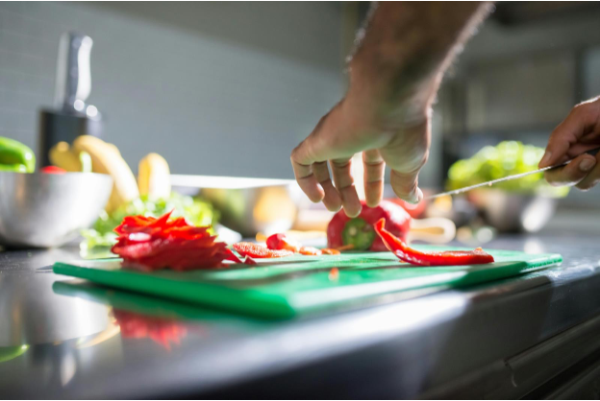
Master Basic Knife Skills
August 5, 2025 - Gary Libretti
Before you start preparing food, take a few minutes to set up your kitchen to make the process safer, faster, and more enjoyable. From setting up your space to using a knife like a pro, here's what you need to know.
1. Set Up a Clean and Organized Workspace
- Clean your surfaces: Wipe down countertops with hot, soapy water, sanitizing and disinfecting a necessary. Click here to learn the differences between cleaning, sanitizing, and disinfecting.
- Gather your tools: Have your knife, cutting board, bowls, measuring tools, and ingredients within reach.
- Avoid clutter: Keep only what you need on the counter. Store away extra items to give yourself room to work.
- Wash your hands with soap and water for at least 20 seconds before and after handling food. Click here for a handwashing tutorial.
- Dry hands and tools: Wet hands or slippery tools can cause accidents.
2. Knife Basics: Choosing, Holding, and Using a Knife
- Use the right knife: An 8-inch chef’s knife is a versatile choice for most tasks. Paring knives are better for small items.
- Pinch grip: Grip the knife with your thumb and index finger near the bolster (where the handle meets the blade). Secure your grip on the handle with your remaining three fingers firmly, but not overly tight grip.
- Claw grip: To protect your fingers while cutting, hold your food on the cutting board under curled fingertips, tucked like a claw. Use the knuckles of your fingers to act as a guide to the side of the kitchen knife.
- Rock chop: Using a rocking motion back and forth with the blade, the knife stays on the cutting board while slicing.
3. Cutting Board Safety
- Use a stable board: Prevent slipping by placing a damp towel or non-slip mat under your cutting board. Thicker boards are more stable than thinner ones and are less likely to warp over time. One-inch-thick boards have a good balance of stability and weight.
- Clean between uses: Wash the board with hot, soapy water. Plastic, glass, and nonporous acrylic can be washed in the dishwasher. Avoid placing laminated boards in the dishwasher.
- Use designated boards: When possible, use separate cutting boards for raw meats from other food items.
4. Knife Cuts to Know
- Slicing: Make even cuts using the full length of the blade by pulling the knife through the item from the base of the blade through to the end of the tip. Slicing uses a rocking motion of the knife pulling the blade back towards you during the cut. This is used for items like onions or tomatoes to make smooth slivers of vegetables.
- Dicing: Cut food into even-sized cubes. Commonly used for potatoes, onions, and other vegetables for even cooking and distribution of flavor.
- Chopping: A general term for cutting food into smaller pieces with a range of sizes and shapes. The cutting motion tends to use more up and down force to lift the knife through the food.
- Julienne: Slice vegetables into thin, matchstick-like pieces.
- Mince: Cut ingredients into very small pieces, often used for aromatics such as garlic or herbs.
- Chiffonade: For making ribbon cuts, roll leafy green vegetables such as basil or spinach before making thin cuts.



 Print
Print Email
Email





